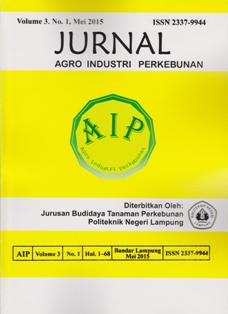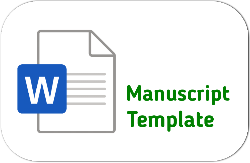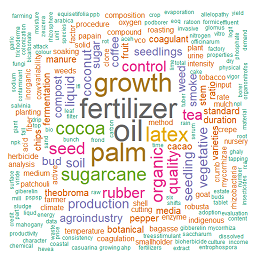Pengaruh Konsentrasi Stimulan dan Intensitas Sadap pada Produksi Lateks Tanaman Karet Seedling (Hevea brasiliensis Muell. Arg.)
DOI:
https://doi.org/10.25181/aip.v3i1.19Abstract
The lacks of national latex productivity caused by most of rubber trees (85%)managed by folks plantations which have low productivities. Good management and performance of cultivation needs for increase latex productivity, mainly in tapping process. The purpose of this research was to study about effects of ethepon stimulant application on seedling rubber trees,determine the proper tapping intensity, and to find out interaction between stimulant applications with tapping intensitytowards seedling rubber trees.The study have been done during 3 months from September to November 2014 using Randomized Complete Block Design (RCBD) factorial with 2 factor. The first factor wasstimulant concentration (C) with 2 stage, C0 = without stimulant application and C1 = stimulant application as recommended rate. The second factor wastapping intensity (I) with 3 stage. I1= once every two days, I2= once every 3 days, and I3= once every 4 days.Thus obtained 6 treatment combinationwith 4 repeats. The study result shows that the latex and dry rubber production towards seedling rubber trees could be increased by stimulant application, tapping intensity did not give effect on increasing latex volume and dry rubber production, and there is no interaction between stimulant applications with tapping intensity.Keywords: latex production, seedling rubber trees,stimulant, tapping intensityPermalink:Â http://jurnal.polinela.ac.id/index.php/AIP/article/view/19Downloads
References
Boerhendhy. 2006. Cara dan Metode Aplikasi Stimulan pada Tanaman Karet. http://www.perkebunanku.com/2014/04.html.%20Diakses%2010%20Mei%202014. [Diakses 26 Juni 2015].
Boerhendhy, I. dan K. Amypalupy. 2010. Optimalisasi Produktivitas Karet Melalui Penggunaan Bahan Tanam, Pemeliharaan, Sistem Eksploitasi dan Peremajaan Tanaman. Balai Penelitian Sembawa. Banyu Asin.
Diennazola, R., S. Utama, dan W. Listianingsih. 2012. Sadap Dengan Benar, Produksi Optimal. Tabloid Agribisnis Agrina. http://www.Agrina-Online.com. [Diakses 26 Juni 2015].
Direktorat Jenderal Perkebunan. 2013. Peningkatan Produksi, Produktivitas Dan Mutu Tanaman Tahunan. Direktorat Jenderal Perkebunan. Jakarta.
Direktorat Jendral PPHP. 2014. Potensi dan Perkembangan Pasar Ekspor Karet Indonesia di Pasar Dunia. Direktorat Jendral PPHP. Jakarta. http://www.pphp.pertanian.go.id. [Diakses 2 Juni 2014].
Nasaruddin dan D. Maulana. 2009. Produksi Tanaman Karet Pada Pemberian Stimulan Ethepon. Universitas Hassanudin. Makasar.
Siregar, T. 1995. Teknik Penyadapan Karet. Kanisius. Yogyakarta.
Suryawibowo, A., D. Supriyatdi, dan M. Rofiq. 2013. Pengaruh konsentrasi stimulan ethepon pada produksi lateks. Jurnal Agro Industri Perkebunan 1(1): 55-62.
Downloads
Published
How to Cite
Issue
Section
License
Authors who publish with Jurnal Agro Industri Perkebunan agree to the following terms:
Authors retain copyright and grant the Jurnal Agro Industri Perkebunan right of first publication with the work simultaneously licensed under a Creative Commons Attribution License (CC BY-SA 4.0) that allows others to share (copy and redistribute the material in any medium or format) and adapt (remix, transform, and build upon the material for any purpose, even commercially) with an acknowledgment of the work's authorship and initial publication in Jurnal Agro Industri Perkebunan.
Authors are able to enter into separate, additional contractual arrangements for the non-exclusive distribution of the journal's published version of the work (e.g., post it to an institutional repository or publish it in a book), with an acknowledgment of its initial publication in Jurnal Agro Industri Perkebunan. Authors are permitted and encouraged to post their work online (e.g., in institutional repositories or on their website) prior to and during the submission process, as it can lead to productive exchanges, as well as earlier and greater citation of published work.


























